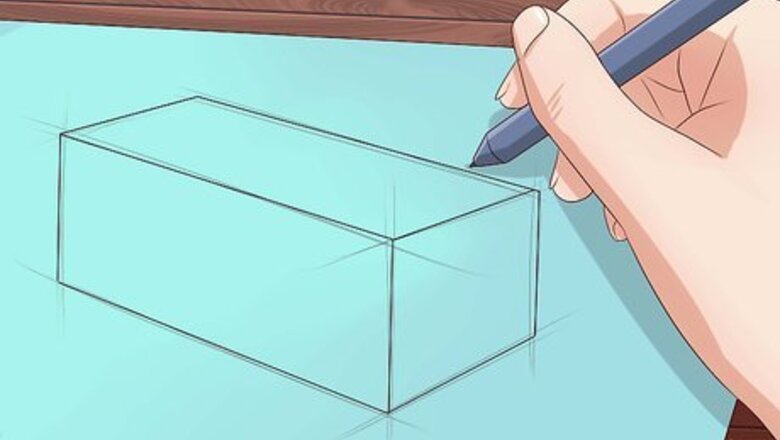
views
Paper Prism
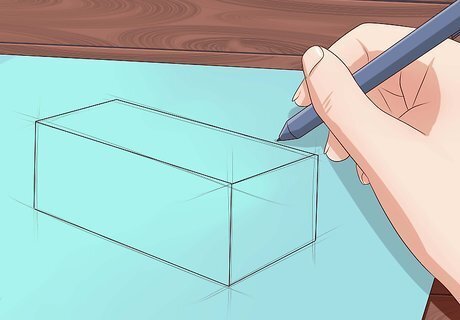
Review the dimensions. Before building a rectangular prism, you will need to know the desired length, width, and height of that prism. Write those dimensions down and refer to them throughout the process. Example: Consider the steps you'll need to follow when constructing a rectangular prism with a length of 6 inches (15 cm), a width of 4 inches (10 cm), and a height of 3 inches (7.6 cm).
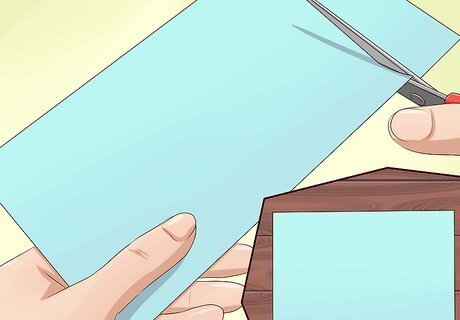
Measure and cut two length by width rectangles. On a sheet of heavy construction paper, use a ruler and pencil to draw two rectangles. The length of each rectangle should match the length of the final prism, and the width of the two rectangles should match the width of the final prism. After drawing both rectangles, use the ruler to measure them again. Both rectangles must be equal in size and must accurately match the length and width of the rectangular prism you wish to create. Once you are certain that both rectangles are the correct length and width, cut them out with sharp scissors. Note that these two rectangles will form the top and bottom of your rectangular prism. Example: Measure and cut two rectangles, each with a length of 6 inches (15 cm) and a width of 4 inches (10 cm).

Measure and cut two length by height rectangles. Use a ruler and pencil to draw two more rectangles from heavy construction paper. The length of these rectangles should match the length of the rectangular prism, but the width of these rectangles will need to match the height of the final rectangular prism. Re-measure the two rectangles after drawing them to check for accuracy, then use sharp scissors to cut both of them out. These two rectangles will eventually form the front and back of your rectangular prism. Example: Measure and cut two rectangles, each with a length of 6 inches (15 cm) and a width of 3 inches (7.6 cm).
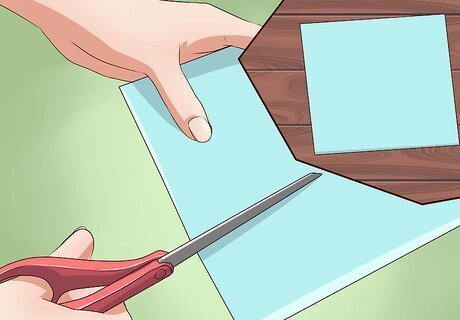
Measure and cut two width by height rectangles. Sketch two more rectangles on heavy construction paper using a ruler and pencil. The length of each rectangle should match the width of the rectangular prism, and the width of each rectangle should match the height of your rectangular prism. After drawing both rectangles, measure them again to check for accuracy before cutting them both out with scissors. These two final rectangles will form the left and right sides of the rectangular prism. Example: Measure and cut two rectangles, each with a length of 4 inches (10 cm) and a width of 3 inches (7.6 cm).
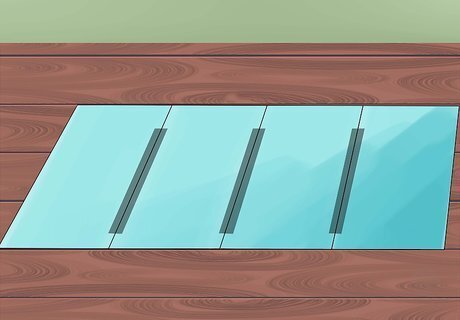
Loosely tape four rectangles into a strip. Line up the length-by-width rectangles and the length-by-height rectangles, alternating back and forth between the two types. Tape the length sides together on one side of the paper. The paper rectangles should be lined up in the following order: length-by-width, length-by-height, length-by-width, length-by-height. Do not place identical rectangles next to one another. Note that the rectangles should be lined up so that their length sides lie directly next to the length side of the adjacent rectangle. Apply one to two strips of tape to each shared edge. When finished, all four rectangles should be taped together into one strip. Example: Alternate the 6-inch by 4-inch (15-cm by 10-cm) rectangles with the 6-inch by 3-inch (15-cm by 7.6-cm) rectangles, matching the 6-inch (15-cm) sides together. Tape the 6-inch (15-cm) sides in place.
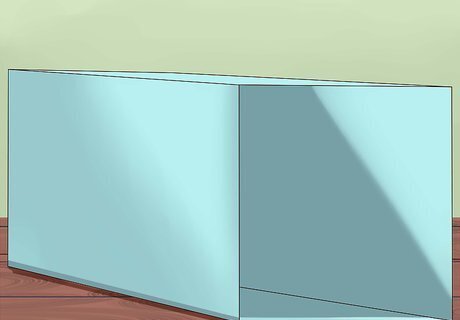
Join the ends of the strip. Fold the strip so that the two unattached length-side ends meet. Use one or two pieces of tape to hold these two ends together. As you fold, make sure that the strip is folding at the edges between separate rectangular faces. You may need to use your thumbnail to crease the tape in between these edges, making it easier to fold. When done, you should have something that looks like a rectangular tube. The prism shape is almost complete, but two sides are still missing at this point. Example: Fold up the strip and tape together the two loose 6-inch (15-cm) sides.
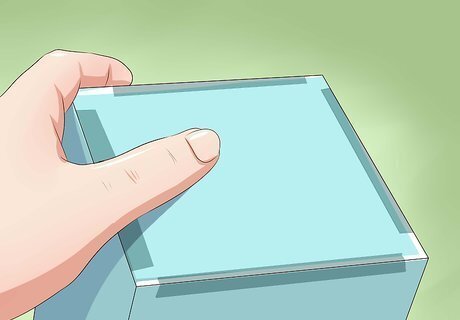
Attach the remaining two rectangles. Position the two remaining rectangles over the two open ends of the shape. Use tape to attach all four sides of each rectangle to the matching sides of the rectangular prism. Make sure that the height side of each rectangle matches the height side of the prism. Likewise, the width side of each rectangle must match the width side of the prism. Start by taping one side of each rectangle in place, then tape the opposite side. The paper should already stay in place at that point, but taping the remaining two sides will provide greater security. Example: Position the 4-inch (10-cm) sides of one rectangle against the 4-inch (10-cm) sides of the rectangular prism. The 3-inch (7.6-cm) sides should naturally match up, as well. Tape the rectangle in place, then repeat with the remaining rectangle.
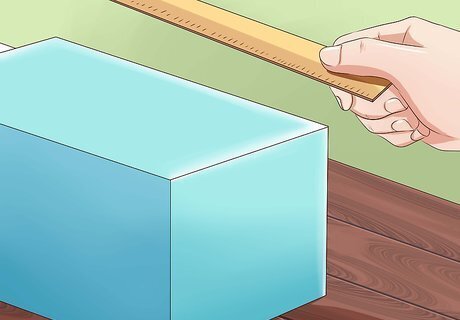
Measure the sides of the finished product. Use a ruler to measure all sides of the finished shape. The length, width, and height dimensions should each match the required dimensions you needed to fulfill. At this point, the rectangular prism is complete. Example: The final rectangular prism should have a length of 6 inches (15 cm), a width of 4 inches (10 cm), and a height of 3 inches (7.6 cm).
Block Prism
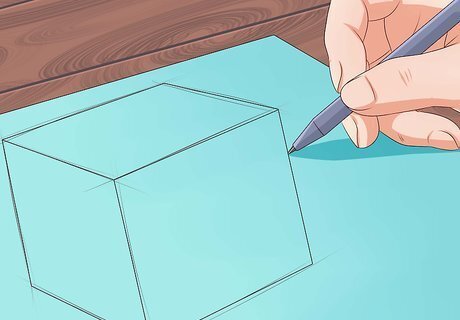
Review the required dimensions. You'll need to know the required length, width, and height of the desired rectangular prism before you can build it. Review these dimensions now and refer to them throughout the construction process. For the sake of simplicity, it might be easiest to work in generic “cubic units” instead of inches or other specific measurements. If you do wish to work in specific inches, you will need to use blocks that measure 1-inch (2.5-cm) on all sides. Square dice measuring 1 inch (2.5 cm) on all sides can be a good option. Example: Consider the steps you'll need to follow to construct a rectangular prism with a length of 4 cubic units, a width of 3 cubic units, and a height of 2 cubic units.
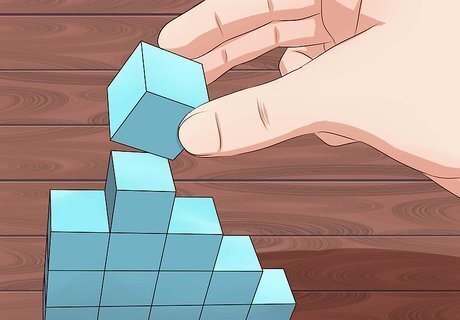
Gather enough blocks. The number of blocks you'll need will match the volume of the final rectangular prism. To find the volume of the rectangular prism, you will need to multiply the length, width, and height together. Note that you must use cubic blocks with equal lengths, widths, and heights. Do not use blocks of any other shape. If desired, you can apply a small strip of double-sided tape or another temporary adhesive to all faces of all blocks. Doing so is not strictly necessary but may make it easier to build the final rectangular prism. Example: To calculate the volume of this rectangular prism, multiply: 4 * 3 * 2 = 24 This signifies that you will need 24 blocks to build this particular rectangular prism.
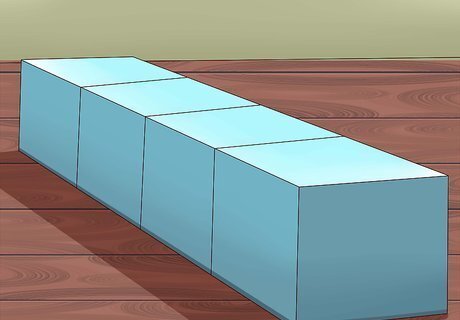
Create a line of blocks to match the length. Line up enough blocks to match the number of cubic units required for the length of the rectangular prism. Keep the line as even as possible. Example: Line up four blocks in an even row.
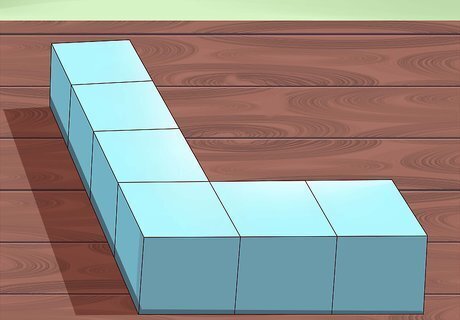
Create a second line to match the width. Starting from the end of your length line, build a second line of blocks that matches the number of cubic units required for the width of your rectangular prism. The total number of blocks in this width edge must match the width of the final prism. This will include the first block already included in the length line. In other words, the number of blocks you will add to the structure during this step will be one fewer than the number of cubic units making up the width of the rectangular prism. Example: Line up two more blocks off one corner of your original line, creating a new perpendicular line containing three blocks total.
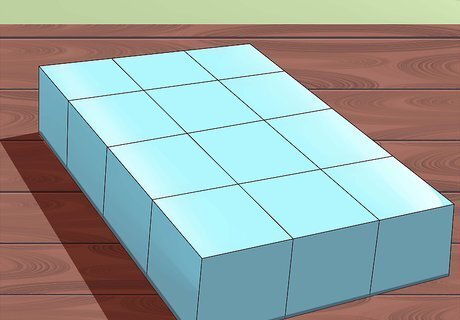
Complete the rectangle. Construct another length and width edge to mirror and match the first two. Fill in the rectangular outline with as many blocks as needed to make the rectangle solid. Count to make sure that the length and width edges match the required length and width of the rectangular prism. You should also count the total number of blocks used for this first rectangular surface. The total number of blocks should match the surface area of the face, which can be calculated by multiplying the length by the width. Example: Build another four-block length edge off the end of the first width edge, then build another three-block width edge between the other end of the two length edges. Fill in the space between with two more blocks. Calculate the surface area by multiplying: 4 * 3 = 12 Count the total number of blocks in this rectangle. There should be 12 blocks total.
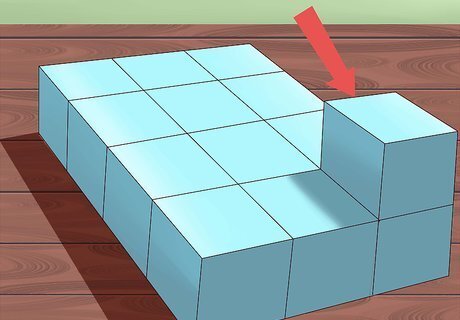
Stack enough blocks to match the height. Starting at one corner of the completed rectangular base, stack enough blocks to equal the required height in cubic units for the desired rectangular prism. As you count the number of blocks in this stack, make sure that you count the bottom block already included in the completed base. The total number of blocks in this stack must equal the total number of cubic units in the height of the prism, so the number of blocks you'll add will actually be one fewer than the number of cubic units required for the height of the prism. Example: Place one block on top of one corner block of your existing rectangle. This should set a height of two blocks (cubic units).
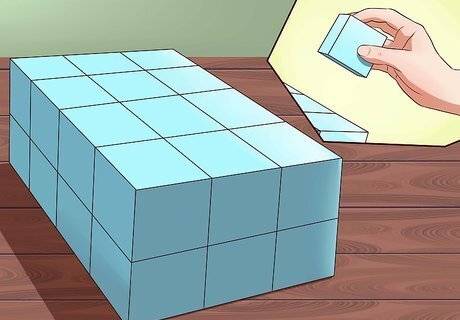
Repeat over the entire rectangle. Build similar stacks of blocks on top of each block in the completed rectangular base. The number of blocks in each of these stacks must match the number of blocks in your first stack and the required height of the rectangular prism. When finished, you should not have any excess blocks left behind. Example: Place one block on top of each of the remaining 11 blocks in your original rectangle. This should use up the remainder of your original 24 blocks.
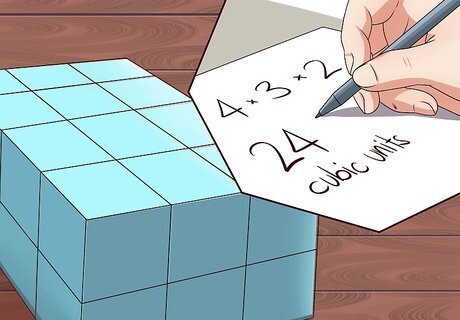
Count the blocks to measure the sides. Measure the sides by counting the number of blocks making up the length, width, and height of the rectangular prism. The blocks making up these sides must match the number of required cubic units for each side of the intended prism. Note that you can also use these block counts to calculate the surface area of each visible face. To calculate surface area, you simply need to multiply the length and width of any face. The volume of the rectangular prism can be calculated, as well, by multiplying the number of blocks making up the length, width, and height of the prism. The volume of the rectangular prism in cubic units should match the number of blocks used to construct the prism. Example: The length of the rectangular prism should contain four blocks, the width should contain three blocks, and the height should contain two blocks. To calculate the surface area of the front and back faces, multiply: 4 * 2 = 8 units To calculate the surface area of the top and bottom faces, multiply: 4 * 3 = 12 units To calculate the surface area of the right and left faces, multiply: 3 * 2 = 6 units To calculate the total volume of the rectangular prism, multiply: 4 * 3 * 2 = 24 cubic units

















Comments
0 comment